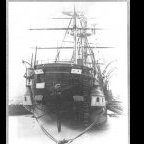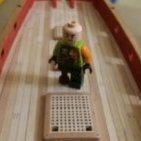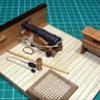Supplies of the Ship Modeler's Handbook are running out. Get your copy NOW before they are gone! Click on photo to order.
×
-
Posts
7,982 -
Joined
-
Last visited
Reputation Activity
-
 Louie da fly got a reaction from popeye the sailor in Thermopylae by Devildog36 - Mantua - 1:124
Louie da fly got a reaction from popeye the sailor in Thermopylae by Devildog36 - Mantua - 1:124
Hi Devildog.Looks like you're making good progress, and I agree with the assessments of the others. One point is that with that very tight curve at the stern you might find planking there a bit of a challenge. Steaming should help a lot, but you might find you have to try it several times before you get it exactly right.
If that's the case, then do it over and over again, rather than settle for "almost right". You'll be glad down the track, because otherwise it will sneer at you every time you look at it, and remind you that with a bit more patience you could have got it right - don't ask me how I know. And this applies to every aspect of the model.Patience and persistence are what it's all about (it's not a race).
-
 Louie da fly got a reaction from EJ_L in 10th-11th century Byzantine dromon by Louie da fly - FINISHED - 1:50
Louie da fly got a reaction from EJ_L in 10th-11th century Byzantine dromon by Louie da fly - FINISHED - 1:50
Thanks, Bigpetr. I don't need it at the moment (too busy manufacturing arms!), but I'll keep your kind offer in mind for later.
-
 Louie da fly got a reaction from mtaylor in 10th-11th century Byzantine dromon by Louie da fly - FINISHED - 1:50
Louie da fly got a reaction from mtaylor in 10th-11th century Byzantine dromon by Louie da fly - FINISHED - 1:50
Nope . . . but I may be able to do something on Paint.
-
 Louie da fly got a reaction from popeye the sailor in Thermopylae by Devildog36 - Mantua - 1:124
Louie da fly got a reaction from popeye the sailor in Thermopylae by Devildog36 - Mantua - 1:124
WalrusGuy, ask away - there are no "stupid questions", and those who know about this stuff are probably checking on this log every now and then. I'll leave it to those more knowledgeable to give the proper information, but I'm pretty sure that for a start those braces (the ropes at the ends of the yards) should lead aft, not forward, on the fore and main masts.
[Edit] Damn! Jim Lad beat me to it! That's the trouble with both being in the same time zone . . . [/Edit]
-
 Louie da fly got a reaction from Keith Black in Thermopylae by Devildog36 - Mantua - 1:124
Louie da fly got a reaction from Keith Black in Thermopylae by Devildog36 - Mantua - 1:124
Hi Devildog.Looks like you're making good progress, and I agree with the assessments of the others. One point is that with that very tight curve at the stern you might find planking there a bit of a challenge. Steaming should help a lot, but you might find you have to try it several times before you get it exactly right.
If that's the case, then do it over and over again, rather than settle for "almost right". You'll be glad down the track, because otherwise it will sneer at you every time you look at it, and remind you that with a bit more patience you could have got it right - don't ask me how I know. And this applies to every aspect of the model.Patience and persistence are what it's all about (it's not a race).
-
 Louie da fly reacted to bigpetr in 10th-11th century Byzantine dromon by Louie da fly - FINISHED - 1:50
Louie da fly reacted to bigpetr in 10th-11th century Byzantine dromon by Louie da fly - FINISHED - 1:50
Louie I can manipulate background image for you, If you want or need.
-
 Louie da fly reacted to Vladimir_Wairoa in Thermopylae by Devildog36 - Mantua - 1:124
Louie da fly reacted to Vladimir_Wairoa in Thermopylae by Devildog36 - Mantua - 1:124
Fingers crossed Devildog. its fine you will fugure it. definitely better to steam planks so you can bend them at critical points around stern. and there is wood filler after all so nothing to be worry about well done. filler might be definite advantage if you want perfect hull. but nothing necessary. without it you may dill it up with file
r after done and sand to perfect shape and after paint or if you want another( thinner) layer of planks its up to you - what helped me was always putting one plank over bulkheads to check if they lay perfectly on so they can be glued - i also sand bulkheafs dame way. with longer srick of wood with sanding paper on. so make sure sanding paper goes always thru at least 2 bulkheads and it will sand off exact amount ...:) well done. Vlad.
-
 Louie da fly reacted to Devildog36 in Thermopylae by Devildog36 - Mantua - 1:124
Louie da fly reacted to Devildog36 in Thermopylae by Devildog36 - Mantua - 1:124
Ok, so I need some positive reinforcement. If a couple of you could be honest I would appreciate the rest sending positive comments. I think the clothing steamer is wonderful. It’s allowing me to form the planks easily. I just started the compound bends with twist and feel ok it’s it. I’m thinking I will cover the hull with filler and sand smooth before applying the outer hall. I’m also modifying the deck houses as I found an early painting of a ship that had some minor differences and I think it is good practice for me. I didn’t like the look of the rudder so I added a piece of wood to make it more level. I couldn’t find any photos or paintings of my ship Specific but other cutters didn’t have the big gap. And yes that is a Bloody Mary
-
 Louie da fly reacted to BobG in Thermopylae by Devildog36 - Mantua - 1:124
Louie da fly reacted to BobG in Thermopylae by Devildog36 - Mantua - 1:124
You're moving along at warp speed, Devildog36! These clipper ships have beautiful lines and it's great to see a model of the Thermopylae currently being build. I'll take a seat and enjoy the show.
You can get a great base for the second planking with filler and sanding. I do see that you have some gaps between the planks. That won't be a problem with the first planking since you will be using filler but, on the second planking, you will want to try and achieve a tighter fit. Be sure to read some planking tutorials about tapering the planks and beveling the top edge when necessary to help obtain a tight fit. Glenn Barlow recently posted this excellent, brief tutorial on how he goes about planking the hull:
Good luck on your build. You're off to a great start.
-
 Louie da fly got a reaction from druxey in Translation help needed - Renaissance German
Louie da fly got a reaction from druxey in Translation help needed - Renaissance German
Thanks, Matle. Von Grünenberg, as is to be expected from a member of the mediaeval/renaissance ruling class, was almost obsessed with heraldry, and I'd be prepared to believe that every coat of arms portrayed is accurate.
Yes, that one I knew from the text. But the fortifications shown are not as they are now.
Either the artist got it wrong or (more likely) they were rebuilt to cope with the new more powerful cannons coming into use at this time. Tall walls and tall towers were vulnerable, and new, more compact forms were coming in - see the fortifications of Malta which were built in the first half of the 16th century.
[Edit]Compare this with the marine gate at Rhodes, built when artillery wasn't such an issue, and the main thing to guard against was people scaling the walls. So walls were built very high, with battlements to deter climbers and infantry. Cannons changed all that - one of the main reasons the Turkish conquest of Constantinople succeeded.
And here's some information about von Grünenberg himself - https://www.petersommer.com/blog/another-view/gruenenberg-1486-croatia-greece - apparently he was the artist! And you can find the whole book at https://digital.blb-karlsruhe.de/blbhs/content/thumbview/7681 - amazing! I'm very glad I followed this up. Strangely, one of the pics I'm most interested in - of Sibenik in Croatia (because it has a great picture of a carrack in it) in this version the ship is different.
This is the one I'd like to get in more detail: it's attributed to von Grünenberg
And this is what the above archive has:
Same city, same configuration, same coat of arms (though reversed out), but different. Presumably they re-drew the pic for another edition. Dammit!
Oh, and if you want some more carracks, the Peregrinatio in Terram Sanctum (Pilgrimage in the Holy Land) by von Breydenbach has some good pictures; https://www.alamy.com/stock-photo/von-breydenbach.html
[/Edit]
-
 Louie da fly got a reaction from GrandpaPhil in 10th-11th century Byzantine dromon by Louie da fly - FINISHED - 1:50
Louie da fly got a reaction from GrandpaPhil in 10th-11th century Byzantine dromon by Louie da fly - FINISHED - 1:50
Thanks everybody for all the likes and comments.
Christos, glad you like the background. There was a discussion earlier in the build regarding the oarblade width - I was also worried they were too narrow, but (i) they had to fit through the oarports which are copied from one of the Yenikapi galleys, (ii) they were based on Byzantine illustrations (though if I had to do it again I'd make the blades taper more slowly, so the blade would come higher up the shaft as shown here)
and (iii) I was assured that this is a representative width for an oarblade propelling a decent sized vessel - I've had a quick look for it in the (45 pages of) my build log but can't find it at the moment.
Banyan, that's a tempting thought, but I think I'd be happy just to blow the picture up bigger so it forms a background. There's another one that's even nicer (got it off Pinterest) which I'd like to use even more than the one above.
But each of them contains a picture of a dromon that I don't believe is correct. I could probably photoshop it out, though, or just put the model in front so it can't be seen.
-
 Louie da fly got a reaction from mtaylor in 10th-11th century Byzantine dromon by Louie da fly - FINISHED - 1:50
Louie da fly got a reaction from mtaylor in 10th-11th century Byzantine dromon by Louie da fly - FINISHED - 1:50
The pictures certainly suggest that's how they were made, but until we find a real one, we can only use "best guess".
-
 Louie da fly got a reaction from goetzi73 in 10th-11th century Byzantine dromon by Louie da fly - FINISHED - 1:50
Louie da fly got a reaction from goetzi73 in 10th-11th century Byzantine dromon by Louie da fly - FINISHED - 1:50
Thanks everybody for all the likes and comments.
Christos, glad you like the background. There was a discussion earlier in the build regarding the oarblade width - I was also worried they were too narrow, but (i) they had to fit through the oarports which are copied from one of the Yenikapi galleys, (ii) they were based on Byzantine illustrations (though if I had to do it again I'd make the blades taper more slowly, so the blade would come higher up the shaft as shown here)
and (iii) I was assured that this is a representative width for an oarblade propelling a decent sized vessel - I've had a quick look for it in the (45 pages of) my build log but can't find it at the moment.
Banyan, that's a tempting thought, but I think I'd be happy just to blow the picture up bigger so it forms a background. There's another one that's even nicer (got it off Pinterest) which I'd like to use even more than the one above.
But each of them contains a picture of a dromon that I don't believe is correct. I could probably photoshop it out, though, or just put the model in front so it can't be seen.
-
 Louie da fly got a reaction from GrandpaPhil in 10th-11th century Byzantine dromon by Louie da fly - FINISHED - 1:50
Louie da fly got a reaction from GrandpaPhil in 10th-11th century Byzantine dromon by Louie da fly - FINISHED - 1:50
Some more oarsmen, and a nice background picture. It's a reconstruction of the Byzantine harbour of Theodosius (where the Yenikapi ships were found). It would be good to make one of those background pictures big enough to look like it's a real background, but I'll have to wait till lockdown is over so I can get to a shop that does it.
My wife tells me I have to stop making these figures, otherwise I'll go blind. I've decided I'll only do it till I need glasses.
Oh.
-
 Louie da fly got a reaction from popeye the sailor in Thermopylae by Devildog36 - Mantua - 1:124
Louie da fly got a reaction from popeye the sailor in Thermopylae by Devildog36 - Mantua - 1:124
I'll pull up a chair, if you don't mind.Looks like an interesting project, and you're off to a good start.
Regarding the orientation of the photos, I've had success saving the photo to a file on my computer, then rotating it and re-saving it if its orientation was wrong, and only then uploading it to the build log. Sometimes it's up the right way in the file but wrong in the build log. If that's the case, I delete the uploaded one from the log and go back and rotate it again till it all comes out right. Others who are more tech savvy might have a better way to do it, but this seems to work for me.
Regarding rigging, there's a whole section in this forum just related to it. Just go to the home page and you'll see it about halfway down the page. Rigging is very date-specific - twenty years can make a big difference. There are books out there which others should be able to refer you to (not my field - I know nothing baout the rigging of this period) which should be able to help you a lot. Also look at other Thermopylae build logs, and perhaps others from ships of the same time like Cutty Sark, which should give you some pointers.
BTW, just a bit of historical interest, "Thermopylae" means "hot gates" in Ancient Greek. The "gates" were the narrow pass across the mountains, the "hot" was because there were hot springs there.
Looking forward to watching progress on this one.
-
 Louie da fly got a reaction from BANYAN in 10th-11th century Byzantine dromon by Louie da fly - FINISHED - 1:50
Louie da fly got a reaction from BANYAN in 10th-11th century Byzantine dromon by Louie da fly - FINISHED - 1:50
Thanks everybody for all the likes and comments.
Christos, glad you like the background. There was a discussion earlier in the build regarding the oarblade width - I was also worried they were too narrow, but (i) they had to fit through the oarports which are copied from one of the Yenikapi galleys, (ii) they were based on Byzantine illustrations (though if I had to do it again I'd make the blades taper more slowly, so the blade would come higher up the shaft as shown here)
and (iii) I was assured that this is a representative width for an oarblade propelling a decent sized vessel - I've had a quick look for it in the (45 pages of) my build log but can't find it at the moment.
Banyan, that's a tempting thought, but I think I'd be happy just to blow the picture up bigger so it forms a background. There's another one that's even nicer (got it off Pinterest) which I'd like to use even more than the one above.
But each of them contains a picture of a dromon that I don't believe is correct. I could probably photoshop it out, though, or just put the model in front so it can't be seen.
-
 Louie da fly got a reaction from BETAQDAVE in Greetings from Germany!
Louie da fly got a reaction from BETAQDAVE in Greetings from Germany!
Welcome, Strelok. Make sure you make a note on this thread when you've started your Golden Yacht build log. I for one would like to watch the progress!
-
 Louie da fly got a reaction from FriedClams in Viking longship by Cathead - Dusek - 1:35 - FINISHED
Louie da fly got a reaction from FriedClams in Viking longship by Cathead - Dusek - 1:35 - FINISHED
I've bookmarked this clamping technique. Simple, elegant and brilliant!
-
 Louie da fly got a reaction from mbp521 in Viking longship by Cathead - Dusek - 1:35 - FINISHED
Louie da fly got a reaction from mbp521 in Viking longship by Cathead - Dusek - 1:35 - FINISHED
I've bookmarked this clamping technique. Simple, elegant and brilliant!
-
 Louie da fly got a reaction from Cathead in Oseberg Viking Ship by liteflight - Billing Boats - 1/25 Scale - 9th Century
Louie da fly got a reaction from Cathead in Oseberg Viking Ship by liteflight - Billing Boats - 1/25 Scale - 9th Century
No, not Celtic! This is an early Viking style - gripping beasts, not knotwork. (Though perhaps Celtic-influenced). Back in my re-enactment days I did a bit of knotwork. It's amazingly difficult to get it all to work together, and just as you think it's all ok you find this piece of tendril is supposed to go under that piece but goes over instead, and there's no way you can fix it without starting all over again!
Oh, come on now. Only 48, really!
We still say that in my family. And I love
"God in His wisdom made the fly
And then forgot to tell us why."
-
 Louie da fly got a reaction from Cathead in Oseberg Viking Ship by liteflight - Billing Boats - 1/25 Scale - 9th Century
Louie da fly got a reaction from Cathead in Oseberg Viking Ship by liteflight - Billing Boats - 1/25 Scale - 9th Century
Well, I'm glad you've worked out a sequence of actions. Did my suggestions make any sense at all?
Just be aware that the figurehead on the actual ship isn't squared off, and in fact it's in the form of a serpent, head and all. And the other end is the tail.
I think the first photo is quite instructive as to the actual form and layout of the decoration. The source I got the second photo from (Pinterest, I'm afraid) had a note that the figurehead had been "restored" (which could mean anything, I suppose - depends on the condition the figurehead was in when found). But when uncovered the ship looked like this:
Presumably the figurehead was somewhere among the spoil pile . . .
PS: I grew up with the Ogden Nash book "Versus". It contained such gems as the poems about Isobel and Pendelson Birdsong (a wise child - he knew his own father), and of course the animal poems - "Who wants my jellyfish - I'm not sellyfish" and "The camel has a single hump, the dromedary two: Or else the other way around - I'm never sure, are you?"
[Edit: You're probably already aware of the discussion on the Oseberg ship going on at
[/Edit]
-
 Louie da fly got a reaction from EJ_L in 10th-11th century Byzantine dromon by Louie da fly - FINISHED - 1:50
Louie da fly got a reaction from EJ_L in 10th-11th century Byzantine dromon by Louie da fly - FINISHED - 1:50
The pictures certainly suggest that's how they were made, but until we find a real one, we can only use "best guess".
-
 Louie da fly reacted to MESSIS in 10th-11th century Byzantine dromon by Louie da fly - FINISHED - 1:50
Louie da fly reacted to MESSIS in 10th-11th century Byzantine dromon by Louie da fly - FINISHED - 1:50
Steven, thank you very much! Yes thats good thinking. The oars had to be able to pass through the oar holes. So I guess being a little narrow was ballanced by the greater nr of the oars. And also am thinking... it seems normal not to add extra pieces on the oars, it seems that the oars ware better to be made from one piece of wood.
-
 Louie da fly got a reaction from Rik Thistle in 10th-11th century Byzantine dromon by Louie da fly - FINISHED - 1:50
Louie da fly got a reaction from Rik Thistle in 10th-11th century Byzantine dromon by Louie da fly - FINISHED - 1:50
Another 4 oarsmen complete and another 4 started, which brings us to just past halfway.
I've found that getting to halfway has a positive effect on morale. From there on there are more items complete than there are left to do, and with every new item complete the balance shifts further and further that way. So rather than being overwhelmed by how many are left to do, it becomes "only so many left". I found this with making the oarsmen, the oars,and various other things where there were a lot of identical items to do.
Also, when I mix the paint for the tunics (and the flesh colours as well), inevitably I mix far more than I need for just one figure. But as I'm doing four at a time, each one at the extreme end of the row it's in, I can paint the tunics all the same colour without it looking obvious.
-
 Louie da fly reacted to liteflight in Oseberg Viking Ship by liteflight - Billing Boats - 1/25 Scale - 9th Century
Louie da fly reacted to liteflight in Oseberg Viking Ship by liteflight - Billing Boats - 1/25 Scale - 9th Century
In preparation for fitting the frames to the keel, I have been carrying out the preliminary work which I vowed I would do before the ship was too far assembled.
One area to prepare for is the Access holes , both bow and stern in the final frames, which are 4mm plywood
So that all the cut edges would have to be veneered
THINKS I have a thermostatic soldering iron which would be promising to veneer with in small spaces!
Here are the two frames in question, pierced and with a piece of venetian blind let in because
A) the ply was getting too thin at the top of the frame
b) I needed a deck support for the small decks in the prow and stern
Good News, the venetian blind material turns out to be close grained, pale wood, and with the distinctive aroma of a cedarwood!
Veneering of the exposed ply edges is now happening.
I have reverted to PVA diluted 30% with water for veneer adhesive. It is reluctant to "wet" freshly sanded ply so a couple of drops of washing liquid will be added to help this.
The Left Hand frame in the picture above has a continuous bit of veneer applied, and clearly it will follow all the contours, both positive and negative. This is glueing, but I intended to use the soldering iron to attach the veneer (having applied PVA and allowed it to dry.
Needle top PVA bottle just visible at the top of the picture
This was originally a bottle of low-temperature gun oil that I used to lubricate my CO2 engines for model flying. I believe that such oil is now available for paintball guns, which have the same problem of low temperature lubricity.
I will not be veneering the rest of the frames because they have cutouts in them for longditudinal stiffeners, and I would like the veneer to be continuous











